Beth Kephart's Blog, page 35
October 29, 2015
What gives a book its bones, and soul? Jennie Nash, Author Accelerator, and a special offer
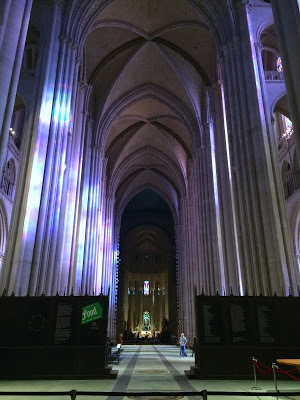 <!-- /* Font Definitions */ @font-face {font-family:Arial; panose-1:2 11 6 4 2 2 2 2 2 4; mso-font-charset:0; mso-generic-font-family:auto; mso-font-pitch:variable; mso-font-signature:3 0 0 0 1 0;} @font-face {font-family:"MS 明朝"; mso-font-charset:78; mso-generic-font-family:auto; mso-font-pitch:variable; mso-font-signature:1 0 16778247 0 131072 0;} @font-face {font-family:Calibri; panose-1:2 15 5 2 2 2 4 3 2 4; mso-font-charset:0; mso-generic-font-family:auto; mso-font-pitch:variable; mso-font-signature:3 0 0 0 1 0;} @font-face {font-family:Cambria; panose-1:2 4 5 3 5 4 6 3 2 4; mso-font-charset:0; mso-generic-font-family:auto; mso-font-pitch:variable; mso-font-signature:3 0 0 0 1 0;} /* Style Definitions */ p.MsoNormal, li.MsoNormal, div.MsoNormal {mso-style-parent:""; margin:0in; margin-bottom:.0001pt; mso-pagination:widow-orphan; font-size:12.0pt; font-family:"Times New Roman"; mso-ascii-font-family:Cambria; mso-ascii-theme-font:minor-latin; mso-fareast-font-family:"MS 明朝"; mso-fareast-theme-font:minor-fareast; mso-hansi-font-family:Cambria; mso-hansi-theme-font:minor-latin; mso-bidi-font-family:"Times New Roman"; mso-bidi-theme-font:minor-bidi;} @page Section1 {size:8.5in 11.0in; margin:1.0in 1.25in 1.0in 1.25in; mso-header-margin:.5in; mso-footer-margin:.5in; mso-paper-source:0;} div.Section1 {page:Section1;} </style> <br /><div class="MsoNormal"><b><span style="color: #0b5394;"><span style="background: white none repeat scroll 0% 0%; font-family: Calibri; font-size: 11pt;">Yesterday I introduced my friend Jennie Nash. It was <a href="http://beth-kephart.blogspot.com/2015... first post in a three-post series that spotlights Jennie's Author Accelerator,</a> a singular program that helps steer authors toward their own finished books. Today, we're continuing that series with Jennie's reflections on process, structure, tone and voice. What gives a book lift, shape, foundation? What makes a story soar? Who is that soul with the voice in the cathedral, finally ready to sing?</span></span></b></div><div class="MsoNormal"><b><span style="color: #0b5394;"><span style="background: white none repeat scroll 0% 0%; font-family: Calibri; font-size: 11pt;"><br /></span></span></b></div><div class="MsoNormal"><b><span style="color: #0b5394;"><span style="background: white none repeat scroll 0% 0%; font-family: Calibri; font-size: 11pt;">As you read, please remember Jennie's offer</span></span></b><span style="color: #0b5394;"><b>—a discount to try out Author Accelerator for a month. The normal price is $199/month, which gives writers four deadlines against which they turn in ten pages for review. Jennie is offering a discounted price of $150 for the first months. Authors can write to Jade@Authoraccelerator.com and ask for the Beth Kephart special offer. That will be good through November 15, 2015. </b></span></div><div class="MsoNormal"><br /></div><div class="MsoNormal"><b><span style="color: #0b5394;"><span style="background: white none repeat scroll 0% 0%; font-family: Calibri; font-size: 11pt;">Author Accelerator encourages authors to think before they write—to map out their desires as writers, articulate their hopes for their projects, ponder requirements like structure and tone. You’ve published eight books yourself. When did you begin to recognize, in your own work, the power of the authorial pause?</span></span></b></div><div class="MsoNormal"><br /></div><div class="MsoNormal"><span style="background: white; color: #548dd4; font-family: Calibri; font-size: 11.0pt; mso-bidi-font-family: "Times New Roman"; mso-fareast-font-family: "Times New Roman";">There has been a certain frantic-ness in my own work for a long time. I was one of those people who wanted to be published before I was 25, because I was restless for success. Each time I wrote another book I would think, “THIS is going to be my big breakthrough book!” I would set arbitrary and very ambitious deadlines for myself – like, “I have to finish this draft in three months.” That can sometimes be good for staying motivated, but if you never let the work breathe, or let yourself breathe, it’s hard to find your voice.<span style="mso-spacerun: yes;"> </span>All that pushing and striving didn’t help me to become a better writer, in the end, or to find any wider success. In fact, it was one of the things that led me to my biggest publishing failure – my last novel, which did not sell. I was so frantic to get the book done and out there and sold, and my desperation was my undoing.</span></div><div class="MsoNormal"><br /></div><div class="MsoNormal"><span style="background: white; color: #548dd4; font-family: Calibri; font-size: 11.0pt; mso-bidi-font-family: "Times New Roman"; mso-fareast-font-family: "Times New Roman";">When I began coaching other writers, I often saw that same frantic energy, and I began to believe that it was the thing that was harming them the most. Rushing to begin, rushing to finish, rushing to publish – these were the biggest problems I was seeing. </span></div><div class="MsoNormal"><br /></div><div class="MsoNormal"><span style="background: white; color: #548dd4; font-family: Calibri; font-size: 11.0pt; mso-bidi-font-family: "Times New Roman"; mso-fareast-font-family: "Times New Roman";">I began to build into my coaching process systems for helping writers to slow down and to THINK. I came to believe that taking the time to be intentional was the most critical step for any writer in any project.<span style="mso-spacerun: yes;"> </span></span></div><div class="MsoNormal"><br /></div><div class="MsoNormal"><span style="background: white; color: #548dd4; font-family: Calibri; font-size: 11.0pt; mso-bidi-font-family: "Times New Roman"; mso-fareast-font-family: "Times New Roman";">It doesn’t mean you have to necessarily <i style="mso-bidi-font-style: normal;">add</i> time to the creative process; stopping to think actually <i style="mso-bidi-font-style: normal;">saves</i>time, in the end. I recently had a client complete a rough draft of a book in about six months of very intense work, but she was very intentional, and she followed the strategic process, and it worked out very well in the end. So pausing to be intentional doesn’t have to mean your process is slow.</span></div><div class="MsoNormal"><span style="color: black; font-family: Calibri; font-size: 11.0pt; mso-bidi-font-family: "Times New Roman"; mso-fareast-font-family: "Times New Roman";"><br /><br /><b><span style="color: #0b5394;"><span style="background: white;">We all think we know what some words mean. But maybe we don’t. How do you define structure? </span></span></b></span></div><div class="MsoNormal"><br /></div><div class="MsoNormal"><span style="background: white; color: #548dd4; font-family: Calibri; mso-bidi-font-family: "Times New Roman"; mso-fareast-font-family: "Times New Roman";">Oh my goodness, this is such a hard question, because structure is such a complex thing! While we might start out by saying structure is the shape of the work – how it unfolds in time, what territory it covers – that is only one small part of it, the surface part of it that we can see, and perhaps graph or outline. Structure is much bigger than that.<span style="mso-spacerun: yes;"> </span>I think of it more like a writer’s <i style="mso-bidi-font-style: normal;">intention</i> for their story.</span></div><div class="MsoNormal"><br /></div><div class="MsoNormal"><span style="background: white; color: #548dd4; font-family: Calibri; mso-bidi-font-family: "Times New Roman"; mso-fareast-font-family: "Times New Roman";">I recently heard Elizabeth Gilbert talk about creativity (because of her new book, <i style="mso-bidi-font-style: normal;">Big Magic</i>, which is an exploration of the creative process) and she said the most extraordinary thing about the beginning of that book idea. She said it took her awhile to start work on it because she didn’t know what the book was going to be. She knew that she would write about creativity, but she didn’t know HOW she would approach the subject. She said that she asked herself,<span style="mso-spacerun: yes;"> </span></span><span style="color: #548dd4; font-family: Arial; mso-bidi-font-family: Arial;">“Does this book want to be a self help, `ten steps to creativity’ book, or `I travel around and interview creative people’ book, or a novel, or an academic neurobiology of creativity book? I had to find out what this book wanted to be.”</span></div><div class="MsoNormal"><br /></div><div class="MsoNormal"><span style="color: #548dd4; font-family: Arial; mso-bidi-font-family: Arial;">That is, in many ways, a perfect explanation of structure – deciding what the idea in your head is going to be, how it’s going to exist in the world, what your intention is for the work. You can see very clearly that Gilbert couldn’t start writing, and couldn’t sketch out a graph for the work or a table of contents or anything representing physical structure and shape, until she knew what the book was going to BE. </span></div><div class="MsoNormal"><br /></div><div class="MsoNormal"><span style="color: #548dd4; font-family: Arial; mso-bidi-font-family: Arial;">Once you make that decision, you create a kind of ecosystem for the work to grow into. It now has certain parameters and limitations. It is going to follow certain conventions – or perhaps break those conventions. That is when you can start looking at how it’s going to do its job. For memoir and non-fiction, you can begin to ask what is going to be in the book and what is going to be left out, where it’s going to start and where it's going to end. For fiction, you can begin to think about who is going to tell the story, where they’re going to stand in time and how much time is going to unfold in the course of the story. </span></div><div class="MsoNormal"><span style="color: black; font-family: Calibri; font-size: 11.0pt; mso-bidi-font-family: "Times New Roman"; mso-fareast-font-family: "Times New Roman";"><br /><br /><b><span style="color: #0b5394;"><span style="background: white;">Voice? </span></span></b></span></div><div class="MsoNormal"><br /></div><div class="MsoNormal"><span style="background: white; color: #548dd4; font-family: Calibri; font-size: 11.0pt; mso-bidi-font-family: "Times New Roman"; mso-fareast-font-family: "Times New Roman";">Voice, to me, is an understanding about who your narrator is and where she stands in time and what her agenda is – her point, her purpose, the reason she is speaking to us in these pages. Voice, in other words, is not just how the narrator sounds or how she (or he!) speaks. It’s all the things the narrator believes and cares about and fears. It’s everything that makes the narrator who she (or he! or it!) is.</span></div><div class="MsoNormal"><br /></div><div class="MsoNormal"><span style="background: white; color: #548dd4; font-family: Calibri; font-size: 11.0pt; mso-bidi-font-family: "Times New Roman"; mso-fareast-font-family: "Times New Roman";">Every book has a narrator, which is obvious in fiction, but in memoir and non-fiction, it’s slightly less obvious. In memoir, the narrator is YOU, of course, but is it you, the twelve year old? You, the thirty year old? You, the person who has <i style="mso-bidi-font-style: normal;">just</i>learned the lessons the story is showing, or you the person who learned those lessons last year, or you the person who is experiencing those lessons as they unfold? You have to chose one narrative voice and stick with it.</span></div><div class="MsoNormal"><br /></div><div class="MsoNormal"><span style="background: white; color: #548dd4; font-family: Calibri; font-size: 11.0pt; mso-bidi-font-family: "Times New Roman"; mso-fareast-font-family: "Times New Roman";">If an author intrudes on the established voice, we can hear it. If a different “you” shows up in a memoir when you didn’t intend her to, we can sense it. These small gaps result in a breech of trust between the reader and the writer, and once you lose trust, you lose everything. That’s why establishing and maintaining a consistent voice is so key.</span><span style="color: black; font-family: Calibri; font-size: 11.0pt; mso-bidi-font-family: "Times New Roman"; mso-fareast-font-family: "Times New Roman";"><br /><br /><span style="color: #0b5394;"><b><span style="background: white;">Tone? </span></b></span></span></div><div class="MsoNormal"><br /></div><div class="MsoNormal"><span style="background: white; color: #548dd4; font-family: Calibri; font-size: 11.0pt; mso-bidi-font-family: "Times New Roman"; mso-fareast-font-family: "Times New Roman";">Tone is how the voice comes across to the reader, what the attitude or stance of the narrator is as she tells the tale or conveys the information. A book can have a desperate and angry tone, or a sad and melancholy tone, or a light and joyous tone. For the longest time, I didn’t want to read <i style="mso-bidi-font-style: normal;">Gone Girl</i>, even though it was all anyone could talk about, because I felt very uncomfortable with the tone of the book. It felt frightening to me, slippery, dark, not to be trusted – and I didn’t want to go to that place. I finally did read it – and of course my sense of the tone was precisely correct. That book had a very strong tone!<span style="mso-spacerun: yes;"> </span></span></div><div class="MsoNormal"><br /></div><div class="MsoNormal"><i style="mso-bidi-font-style: normal;"><span style="background: white; color: #548dd4; font-family: Calibri; font-size: 11.0pt; mso-bidi-font-family: "Times New Roman"; mso-fareast-font-family: "Times New Roman";">Big Magic</span></i><span style="background: white; color: #548dd4; font-family: Calibri; font-size: 11.0pt; mso-bidi-font-family: "Times New Roman"; mso-fareast-font-family: "Times New Roman";">, which I just mentioned, has a very joyous, lighthearted tone. Gilbert talks about some dark things in the book, to be sure, but she does it in a way that is very safe, and ultimately uplifting. In many ways, that’s a triumph of her tone.</span><br /><br /><span style="background: white; color: #548dd4; font-family: Calibri; font-size: 11.0pt; mso-bidi-font-family: "Times New Roman"; mso-fareast-font-family: "Times New Roman";"><span style="color: #0b5394;"><b>Stay tuned for Part 3 of our three-part discussion, when Jennie talks about character, meaning, and intent. </b></span></span></div><div class="feedflare">
<!-- /* Font Definitions */ @font-face {font-family:Arial; panose-1:2 11 6 4 2 2 2 2 2 4; mso-font-charset:0; mso-generic-font-family:auto; mso-font-pitch:variable; mso-font-signature:3 0 0 0 1 0;} @font-face {font-family:"MS 明朝"; mso-font-charset:78; mso-generic-font-family:auto; mso-font-pitch:variable; mso-font-signature:1 0 16778247 0 131072 0;} @font-face {font-family:Calibri; panose-1:2 15 5 2 2 2 4 3 2 4; mso-font-charset:0; mso-generic-font-family:auto; mso-font-pitch:variable; mso-font-signature:3 0 0 0 1 0;} @font-face {font-family:Cambria; panose-1:2 4 5 3 5 4 6 3 2 4; mso-font-charset:0; mso-generic-font-family:auto; mso-font-pitch:variable; mso-font-signature:3 0 0 0 1 0;} /* Style Definitions */ p.MsoNormal, li.MsoNormal, div.MsoNormal {mso-style-parent:""; margin:0in; margin-bottom:.0001pt; mso-pagination:widow-orphan; font-size:12.0pt; font-family:"Times New Roman"; mso-ascii-font-family:Cambria; mso-ascii-theme-font:minor-latin; mso-fareast-font-family:"MS 明朝"; mso-fareast-theme-font:minor-fareast; mso-hansi-font-family:Cambria; mso-hansi-theme-font:minor-latin; mso-bidi-font-family:"Times New Roman"; mso-bidi-theme-font:minor-bidi;} @page Section1 {size:8.5in 11.0in; margin:1.0in 1.25in 1.0in 1.25in; mso-header-margin:.5in; mso-footer-margin:.5in; mso-paper-source:0;} div.Section1 {page:Section1;} </style> <br /><div class="MsoNormal"><b><span style="color: #0b5394;"><span style="background: white none repeat scroll 0% 0%; font-family: Calibri; font-size: 11pt;">Yesterday I introduced my friend Jennie Nash. It was <a href="http://beth-kephart.blogspot.com/2015... first post in a three-post series that spotlights Jennie's Author Accelerator,</a> a singular program that helps steer authors toward their own finished books. Today, we're continuing that series with Jennie's reflections on process, structure, tone and voice. What gives a book lift, shape, foundation? What makes a story soar? Who is that soul with the voice in the cathedral, finally ready to sing?</span></span></b></div><div class="MsoNormal"><b><span style="color: #0b5394;"><span style="background: white none repeat scroll 0% 0%; font-family: Calibri; font-size: 11pt;"><br /></span></span></b></div><div class="MsoNormal"><b><span style="color: #0b5394;"><span style="background: white none repeat scroll 0% 0%; font-family: Calibri; font-size: 11pt;">As you read, please remember Jennie's offer</span></span></b><span style="color: #0b5394;"><b>—a discount to try out Author Accelerator for a month. The normal price is $199/month, which gives writers four deadlines against which they turn in ten pages for review. Jennie is offering a discounted price of $150 for the first months. Authors can write to Jade@Authoraccelerator.com and ask for the Beth Kephart special offer. That will be good through November 15, 2015. </b></span></div><div class="MsoNormal"><br /></div><div class="MsoNormal"><b><span style="color: #0b5394;"><span style="background: white none repeat scroll 0% 0%; font-family: Calibri; font-size: 11pt;">Author Accelerator encourages authors to think before they write—to map out their desires as writers, articulate their hopes for their projects, ponder requirements like structure and tone. You’ve published eight books yourself. When did you begin to recognize, in your own work, the power of the authorial pause?</span></span></b></div><div class="MsoNormal"><br /></div><div class="MsoNormal"><span style="background: white; color: #548dd4; font-family: Calibri; font-size: 11.0pt; mso-bidi-font-family: "Times New Roman"; mso-fareast-font-family: "Times New Roman";">There has been a certain frantic-ness in my own work for a long time. I was one of those people who wanted to be published before I was 25, because I was restless for success. Each time I wrote another book I would think, “THIS is going to be my big breakthrough book!” I would set arbitrary and very ambitious deadlines for myself – like, “I have to finish this draft in three months.” That can sometimes be good for staying motivated, but if you never let the work breathe, or let yourself breathe, it’s hard to find your voice.<span style="mso-spacerun: yes;"> </span>All that pushing and striving didn’t help me to become a better writer, in the end, or to find any wider success. In fact, it was one of the things that led me to my biggest publishing failure – my last novel, which did not sell. I was so frantic to get the book done and out there and sold, and my desperation was my undoing.</span></div><div class="MsoNormal"><br /></div><div class="MsoNormal"><span style="background: white; color: #548dd4; font-family: Calibri; font-size: 11.0pt; mso-bidi-font-family: "Times New Roman"; mso-fareast-font-family: "Times New Roman";">When I began coaching other writers, I often saw that same frantic energy, and I began to believe that it was the thing that was harming them the most. Rushing to begin, rushing to finish, rushing to publish – these were the biggest problems I was seeing. </span></div><div class="MsoNormal"><br /></div><div class="MsoNormal"><span style="background: white; color: #548dd4; font-family: Calibri; font-size: 11.0pt; mso-bidi-font-family: "Times New Roman"; mso-fareast-font-family: "Times New Roman";">I began to build into my coaching process systems for helping writers to slow down and to THINK. I came to believe that taking the time to be intentional was the most critical step for any writer in any project.<span style="mso-spacerun: yes;"> </span></span></div><div class="MsoNormal"><br /></div><div class="MsoNormal"><span style="background: white; color: #548dd4; font-family: Calibri; font-size: 11.0pt; mso-bidi-font-family: "Times New Roman"; mso-fareast-font-family: "Times New Roman";">It doesn’t mean you have to necessarily <i style="mso-bidi-font-style: normal;">add</i> time to the creative process; stopping to think actually <i style="mso-bidi-font-style: normal;">saves</i>time, in the end. I recently had a client complete a rough draft of a book in about six months of very intense work, but she was very intentional, and she followed the strategic process, and it worked out very well in the end. So pausing to be intentional doesn’t have to mean your process is slow.</span></div><div class="MsoNormal"><span style="color: black; font-family: Calibri; font-size: 11.0pt; mso-bidi-font-family: "Times New Roman"; mso-fareast-font-family: "Times New Roman";"><br /><br /><b><span style="color: #0b5394;"><span style="background: white;">We all think we know what some words mean. But maybe we don’t. How do you define structure? </span></span></b></span></div><div class="MsoNormal"><br /></div><div class="MsoNormal"><span style="background: white; color: #548dd4; font-family: Calibri; mso-bidi-font-family: "Times New Roman"; mso-fareast-font-family: "Times New Roman";">Oh my goodness, this is such a hard question, because structure is such a complex thing! While we might start out by saying structure is the shape of the work – how it unfolds in time, what territory it covers – that is only one small part of it, the surface part of it that we can see, and perhaps graph or outline. Structure is much bigger than that.<span style="mso-spacerun: yes;"> </span>I think of it more like a writer’s <i style="mso-bidi-font-style: normal;">intention</i> for their story.</span></div><div class="MsoNormal"><br /></div><div class="MsoNormal"><span style="background: white; color: #548dd4; font-family: Calibri; mso-bidi-font-family: "Times New Roman"; mso-fareast-font-family: "Times New Roman";">I recently heard Elizabeth Gilbert talk about creativity (because of her new book, <i style="mso-bidi-font-style: normal;">Big Magic</i>, which is an exploration of the creative process) and she said the most extraordinary thing about the beginning of that book idea. She said it took her awhile to start work on it because she didn’t know what the book was going to be. She knew that she would write about creativity, but she didn’t know HOW she would approach the subject. She said that she asked herself,<span style="mso-spacerun: yes;"> </span></span><span style="color: #548dd4; font-family: Arial; mso-bidi-font-family: Arial;">“Does this book want to be a self help, `ten steps to creativity’ book, or `I travel around and interview creative people’ book, or a novel, or an academic neurobiology of creativity book? I had to find out what this book wanted to be.”</span></div><div class="MsoNormal"><br /></div><div class="MsoNormal"><span style="color: #548dd4; font-family: Arial; mso-bidi-font-family: Arial;">That is, in many ways, a perfect explanation of structure – deciding what the idea in your head is going to be, how it’s going to exist in the world, what your intention is for the work. You can see very clearly that Gilbert couldn’t start writing, and couldn’t sketch out a graph for the work or a table of contents or anything representing physical structure and shape, until she knew what the book was going to BE. </span></div><div class="MsoNormal"><br /></div><div class="MsoNormal"><span style="color: #548dd4; font-family: Arial; mso-bidi-font-family: Arial;">Once you make that decision, you create a kind of ecosystem for the work to grow into. It now has certain parameters and limitations. It is going to follow certain conventions – or perhaps break those conventions. That is when you can start looking at how it’s going to do its job. For memoir and non-fiction, you can begin to ask what is going to be in the book and what is going to be left out, where it’s going to start and where it's going to end. For fiction, you can begin to think about who is going to tell the story, where they’re going to stand in time and how much time is going to unfold in the course of the story. </span></div><div class="MsoNormal"><span style="color: black; font-family: Calibri; font-size: 11.0pt; mso-bidi-font-family: "Times New Roman"; mso-fareast-font-family: "Times New Roman";"><br /><br /><b><span style="color: #0b5394;"><span style="background: white;">Voice? </span></span></b></span></div><div class="MsoNormal"><br /></div><div class="MsoNormal"><span style="background: white; color: #548dd4; font-family: Calibri; font-size: 11.0pt; mso-bidi-font-family: "Times New Roman"; mso-fareast-font-family: "Times New Roman";">Voice, to me, is an understanding about who your narrator is and where she stands in time and what her agenda is – her point, her purpose, the reason she is speaking to us in these pages. Voice, in other words, is not just how the narrator sounds or how she (or he!) speaks. It’s all the things the narrator believes and cares about and fears. It’s everything that makes the narrator who she (or he! or it!) is.</span></div><div class="MsoNormal"><br /></div><div class="MsoNormal"><span style="background: white; color: #548dd4; font-family: Calibri; font-size: 11.0pt; mso-bidi-font-family: "Times New Roman"; mso-fareast-font-family: "Times New Roman";">Every book has a narrator, which is obvious in fiction, but in memoir and non-fiction, it’s slightly less obvious. In memoir, the narrator is YOU, of course, but is it you, the twelve year old? You, the thirty year old? You, the person who has <i style="mso-bidi-font-style: normal;">just</i>learned the lessons the story is showing, or you the person who learned those lessons last year, or you the person who is experiencing those lessons as they unfold? You have to chose one narrative voice and stick with it.</span></div><div class="MsoNormal"><br /></div><div class="MsoNormal"><span style="background: white; color: #548dd4; font-family: Calibri; font-size: 11.0pt; mso-bidi-font-family: "Times New Roman"; mso-fareast-font-family: "Times New Roman";">If an author intrudes on the established voice, we can hear it. If a different “you” shows up in a memoir when you didn’t intend her to, we can sense it. These small gaps result in a breech of trust between the reader and the writer, and once you lose trust, you lose everything. That’s why establishing and maintaining a consistent voice is so key.</span><span style="color: black; font-family: Calibri; font-size: 11.0pt; mso-bidi-font-family: "Times New Roman"; mso-fareast-font-family: "Times New Roman";"><br /><br /><span style="color: #0b5394;"><b><span style="background: white;">Tone? </span></b></span></span></div><div class="MsoNormal"><br /></div><div class="MsoNormal"><span style="background: white; color: #548dd4; font-family: Calibri; font-size: 11.0pt; mso-bidi-font-family: "Times New Roman"; mso-fareast-font-family: "Times New Roman";">Tone is how the voice comes across to the reader, what the attitude or stance of the narrator is as she tells the tale or conveys the information. A book can have a desperate and angry tone, or a sad and melancholy tone, or a light and joyous tone. For the longest time, I didn’t want to read <i style="mso-bidi-font-style: normal;">Gone Girl</i>, even though it was all anyone could talk about, because I felt very uncomfortable with the tone of the book. It felt frightening to me, slippery, dark, not to be trusted – and I didn’t want to go to that place. I finally did read it – and of course my sense of the tone was precisely correct. That book had a very strong tone!<span style="mso-spacerun: yes;"> </span></span></div><div class="MsoNormal"><br /></div><div class="MsoNormal"><i style="mso-bidi-font-style: normal;"><span style="background: white; color: #548dd4; font-family: Calibri; font-size: 11.0pt; mso-bidi-font-family: "Times New Roman"; mso-fareast-font-family: "Times New Roman";">Big Magic</span></i><span style="background: white; color: #548dd4; font-family: Calibri; font-size: 11.0pt; mso-bidi-font-family: "Times New Roman"; mso-fareast-font-family: "Times New Roman";">, which I just mentioned, has a very joyous, lighthearted tone. Gilbert talks about some dark things in the book, to be sure, but she does it in a way that is very safe, and ultimately uplifting. In many ways, that’s a triumph of her tone.</span><br /><br /><span style="background: white; color: #548dd4; font-family: Calibri; font-size: 11.0pt; mso-bidi-font-family: "Times New Roman"; mso-fareast-font-family: "Times New Roman";"><span style="color: #0b5394;"><b>Stay tuned for Part 3 of our three-part discussion, when Jennie talks about character, meaning, and intent. </b></span></span></div><div class="feedflare"><a href="http://feeds.feedburner.com/~ff/BethK... src="http://feeds.feedburner.com/~ff/BethK..." border="0"></img></a> <a href="http://feeds.feedburner.com/~ff/BethK... src="http://feeds.feedburner.com/~ff/BethK..." border="0"></img></a> <a href="http://feeds.feedburner.com/~ff/BethK... src="http://feeds.feedburner.com/~ff/BethK..." border="0"></img></a> <a href="http://feeds.feedburner.com/~ff/BethK... src="http://feeds.feedburner.com/~ff/BethK..." border="0"></img></a>
</div>
Published on October 29, 2015 02:17
October 28, 2015
Introducing Jennie Nash, Author Accelerator, and a Very Special Offer
 See the wings up there, in that autumnal photograph? That something red getting ready to fly?
See the wings up there, in that autumnal photograph? That something red getting ready to fly?My dear friend and fellow writer/teacher Jennie Nash has created something rather remarkably wing like—and hugely effective—with a program she calls Author Accelerator. It's for those of us who know that it is time to finally write that book, to tell that story (any genre), to put it all down on the page, but who are intimidated by the process. For those whose ideas about form, content, and tone could use a little provocation. For those who hope to be listened to and guided along the writing way. For those who want to write with sincere intent.
As a nationally acclaimed book coach with a wow track record, Jennie doesn't just have ideas about story development. She has proven ideas. Over the past week or so, prompted by a conversation I'd had with another dear friend, Kelly, Jennie and I have been talking about her program. I invited her to come onto my blog for three consecutive days to share her thoughts and process with you.
She, too, has an offer—a discount to try out Author Accelerator for a month. The normal price is $199/month, which gives writers four deadlines against which they turn in ten pages for review. Jennie is offering a discounted price of $150 for the first months. Authors can write to Jade@Authoraccelerator.com and ask for the Beth Kephart special offer. That will be good through November 15, 2015.
Please also visit the authoraccelerator.com homepage for an array of free resources.
Below, please find Part 1 of my interview with Jennie.
Let’s first talk about your amazing success here as the creator of Author Accelerator. Tell us the story of the program’s creation. Tell us when you knew it was working. And tell us about some of those big book deals you’ve helped to ensure through your work as a book coach.
Let’s start with the book coaching, because that’s where it all starts! I fell into coaching quite by accident about five years ago. A colleague of mine at the UCLA Writer’s Program asked if I would help her with her book. She was an agent and a story analyst and didn’t consider herself a “real writer,” so she wanted help in pulling this idea together about the neurobiology of the reader’s brain. Because of the way I teach (which is a very strategic approach to a creative undertaking) she thought I had strategies and systems for book development. The truth was that I didn’t have anything, but I drew on my own writing experiences and on my teaching, and I made up some processes on the fly. They turned out to be enormously effective. Lisa Cron went on to land a top agent and her book, Wired for Story, was published by Ten Speed (a division of Random House). The book has enjoyed great success, and Lisa has actually just finished the follow-up book, Story Genius, which is due out in 2016. A third book will be forthcoming after that.
Meanwhile, other writers kept asking me for the same kind of help, and I began to say yes. This new direction in my career coincided very neatly with my taking a fallow period for my own writing (I talk about why I took a fallow period in one of my answers below), so I had the time to devote to this work, to dig into it, and to really study it. I worked with several clients from zero the way I did with Lisa, and they too landed top agents and book deals – the beautiful memoir, Gatsby Interrupted, by Sam Polk, which is coming out from Scribner in March 2016, and the fabulous self help book, The Next Happy, by Tracey Cleantis, which came out from Hazeldon earlier this year.
In the midst of all that work, I developed the strategy or system everyone assumed I already had!
About three years after I began coaching, I was approached by a startup pro from the UCLA Center for Entrepreneurial Studies. He heard me give a speech to entrepreneurs about how their skills translate to book publishing, and he said it was very unusual to find someone steeped in the creative process who also understood marketing and strategy. He was the one who proposed that I find a way to take my system and make it accessible to a wide range of people – which is how Author Accelerator was born. It's an online coaching program that gives writers weekly accountability and editorial feedback for an affordable price. Our goal is to help writers overcome every obstacle (doubt, procrastination, those deep level WHY problems) so that they can finally finish their books.
I resisted doing this, at first. I’m a writer, not an entrepreneur! But I soon saw how much fun this could be, and how powerful – and both of those things have been true. Author Accelerator is almost two years old and it looks as though it is going to be a viable commercial enterprise – one of the startups that makes it! It’s very different from a lot of online writing programs in that you get hands-on feedback on your work each week all the way through your book-writing process. I’m so proud of what we are doing for so many reasons, not the least of which are our writers, who are so dedicated and inspiring, and my team of editors, whom I have trained and oversee, and who are so engaged in their work.
(stay tuned for Part 2 of our conversation, tomorrow)




Published on October 28, 2015 02:02
October 27, 2015
Tim Wynne-Jones rocks (and he had kind things to say about This Is the Story)
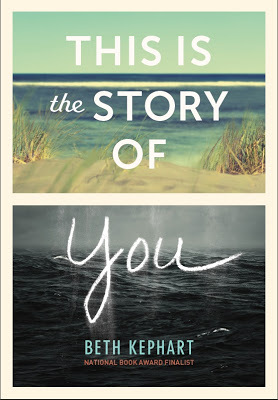 You know how I adored the Bank Street conference. You know how much I think of Tim Wynne-Jones's new book,
The Emperor of Any Place
(and Tim himself). And you know what a rock star Tim is, Tim who is practically the King of Canada, he's so good, who has won more awards for his wide-ranging books than I have the brain cells to count.
You know how I adored the Bank Street conference. You know how much I think of Tim Wynne-Jones's new book,
The Emperor of Any Place
(and Tim himself). And you know what a rock star Tim is, Tim who is practically the King of Canada, he's so good, who has won more awards for his wide-ranging books than I have the brain cells to count.And look, just now, here is Shelf Awareness, reaffirming what we all already knew.
So you can imagine how very happy I am that Tim took the time, not long ago, to read This Is the Story of You. He taught me something new about the book. He shared these words. They will grace the book, alongside Dana Reinhardt's gorgeous kindness when it comes out next spring from Chronicle Books.
It is the book that finally answers that age-old question what if you were a castaway thrown up on the shores of your own life. Isn't it amazing what a storm blows in: memories and mysteries. So much lost and then something found amidst the shattered flotsam -- something you couldn't have even known you were missing. A beautiful story. — Tim Wynne-Jones, Officer of the Order of Canada and award-winning author of The Emperor of Any Place, among many other titles




Published on October 27, 2015 07:56
October 26, 2015
"Landscape": new (award-winning) work by my husband
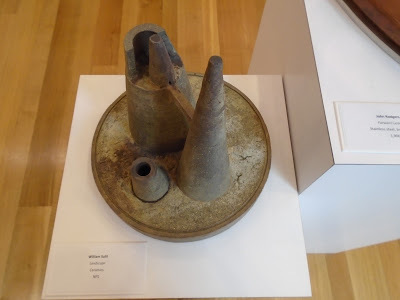
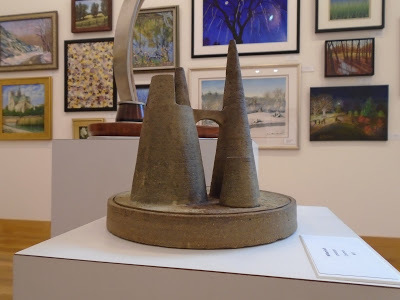 The first time I ever saw my husband's art was after a softball game played at Memorial Hall, on the former Centennial grounds in Philadelphia. He was working primarily with watercolors then—almost-abstract landscapes on postcard-sized rectangles that depicted imaginary, possibly believable places.
The first time I ever saw my husband's art was after a softball game played at Memorial Hall, on the former Centennial grounds in Philadelphia. He was working primarily with watercolors then—almost-abstract landscapes on postcard-sized rectangles that depicted imaginary, possibly believable places.In nearly uncountable ways and within an astonishing array of media, Bill has carried those motifs forward—and now he is translating them into clay. He's building bridges and tunnels inside cones and squares, perfecting surfaces in a medium that is notorious for having a mind of its own. He does that work quietly for hours every day in a basement studio, and then again on Wednesdays, among our friends at the Wayne Art Center.
Yesterday, a beautiful autumn day, we were grateful that that work was awarded the Wayne Art Center Ceramics Award at the Fall 2015 Members' Exhibition.




Published on October 26, 2015 04:11
October 25, 2015
NYC in 36 hours
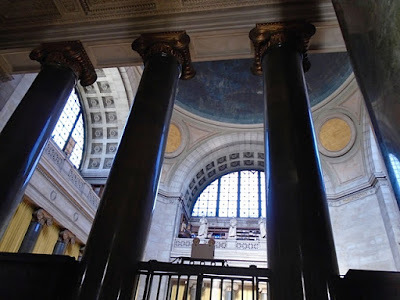






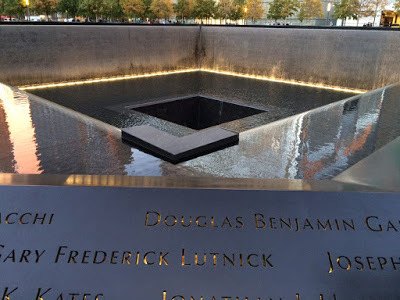 Some day I'll be too old for this. This insistence (within myself/for myself) that I live each minute, see each place, feel each thing I can find my way to.
Some day I'll be too old for this. This insistence (within myself/for myself) that I live each minute, see each place, feel each thing I can find my way to.But I'm not there yet. I'm still the woman who arrives mid-afternoon to New York City, checks into a hotel with her husband, and starts to walk. This time to the Columbia University campus, which I had never seen (that old library, now the administration building, soars). To the Cathedral Church of St. John the Divine. Past the fruit vendors on upper Broadway.
Then a subway ride to Columbus Circle and the Museum of Arts and Design (where an exquisite Wendell Castle show is in place). Then a walk-run (to the extent possible) through Times Square, and then more underground tunnels to the World Trade Center, where we were stopped by the power of those two pools, the remembered names, the roses and calla lilies left in respect and honor. Art can speak, and this art does—the down and the down of the water, the sound of that water, the return of the water, and the light behind the names.
It was the hour of the gloaming. The stone buildings burned red-orange inside the blue glass of the new tower, and that big Calatrava bird, soon to be the World Trade Center Transportation Center, was already soaring.
We walked a long length of Greenwich, then, met our son for dinner, watched him take off in an Uber for a date, made our way all the way back to 103rd Street, where all night long we listened to the trash trucks, the buses, the NYC talk just outside our window. I rose in the dark, put on a dress, and as soon as the sun was up I was walking again—finding a French bakery, buying an almond croissant, and working my way toward Central Park, where the early dog walkers were out and about and I could see the river just beyond them.
By 8:15 I was dancing with the extraordinary educator/advocator Susannah Richards in the lobby of Bank Street. Dancing, yes. I swear we danced. (Susannah is especially good at the twirls.) At Bank Street, a remarkable cast of writers, illustrators, educators, librarians, and book people were convening for what, in my book, is the best gathering of storytellers ever anywhere. Here the conversation circles around Thoughts as opposed to Marketing Platforms. The forum encourages conversation, consideration, a maybe this or a maybe that. This is hardly accidental. This reflects the good work of those who assemble this program, moderate the panels, conduct the keynote (thank you, Rita Williams-Garcia), and say yes. I bow down to you, oh Bank Street, with thanks especially to Jennifer Brown and Cynthia Weill, and then to my fellow panelists Daniel Jose Older and Tim Wynne-Jones—the three us led toward greater understanding about narrative risk by the exceptionally thoughtful questions of Vicki Smith of Kirkus Reviews. And with thanks to Chronicle Books, who said yes to the event.
When it was done, when I hugged my old and new friends goodbye, I was running again, to the subway, to the PATH, and toward my husband and son, where we walked some more, had an early dinner, and watched the lights of the World Trade Center blink on.
(Can I just thank here the little boy on the incredibly crowded train who must have read the panic of this claustrophobe on his face and said, "Miss? Do you want my seat?")
We drove home in the dark. I slept. I actually slept. The sleep of a satisfied woman.




Published on October 25, 2015 04:09
October 23, 2015
these things are happening (and the countless countless)
 Look. We come around to this. Again and again, we do. We are living with a book newly launched (though perhaps we wrote pieces of it years ago). We are grateful for the invitations extended, grateful for a chance to sing the book's song, eager not to fail those who have been kind enough to open their doors to us—and also aware that every time we mention our own book we are not talking about the countless million million things that matter much more deeply than ever our own books could.
Look. We come around to this. Again and again, we do. We are living with a book newly launched (though perhaps we wrote pieces of it years ago). We are grateful for the invitations extended, grateful for a chance to sing the book's song, eager not to fail those who have been kind enough to open their doors to us—and also aware that every time we mention our own book we are not talking about the countless million million things that matter much more deeply than ever our own books could.(Refuges. Candidates. Hunger. Homelessness. Heartbreak. Danger. Unexpected and unimaginable losses. Aging. Love suspended.)
It has always been important to me to use this blog to celebrate the world and the work of others. To raise questions. To be honest. To admit: I'm failing right now. I'm not writing right now. I'm stuck right now. I screwed that up. I should have— Also to admit: I have been graced. I have been blessed. I know luck when I see luck.
That's what I'm here to talk about and I am (believe me) aware when I lose the hoped-for balance.
This, however, is also true. Book stores make room. Festivals provide opportunities to think out loud with people I respect. The ladies of Laurel Hill are throwing a fundraiser and I've promised to help them tell that story.
Forgive the apparent self indulgence.
I promise that it is almost over. That I am stockpiling books to read with an eye toward the future of this blog when, in just a few weeks, I won't be talking about me.
But for now, this weekend: I am blessed beyond measure to be included in the BookFest@Bank Street, on Saturday. I'll be talking about narrative risk in young adult literature with three people I hugely respect, and I'm going to learn so much (not just from that panel but from every single other person who is attending—what a list).
Sunday, October 25, I'll be talking with the wonderful voice of KYW, Brad Segall, about Philadelphia and some of the Philadelphians I love (go Sister Kim and her girls!) on WOGL 98.1 FM and WZMP 96.5 FM at 6:30 AM and on WXTU at 92.5 FM at 7:30 AM. Later that afternoon, at 4 PM, I'll be at Main Point Books, a glorious Indie on Lancaster Avenue in Bryn Mawr, signing One Thing Stolen and Love. And next Sunday I will be at the Women for Greater Philadelphia annual fundraiser, there at Laurel Hill Mansion, a public event. We'll be celebrating the Schuylkill River by reading from Flow and two novels—Dangerous Neighbors and Dr. Radway's Sarsaparilla Resolvent—where the river features boldly.
Where I live, on this morning, the sky is breaking blue.
It is another day.
That is the greatest miracle of all.




Published on October 23, 2015 04:50
October 22, 2015
city lights, and she remembers the first moving stairs (in Philadelphia)
 Last evening, at the Cultural Series at the Kennedy House, we were talking about Philadelphia then. "We" were the wonderful Philadelphians in a 30th-floor room, shoulder to shoulder with memory.
Last evening, at the Cultural Series at the Kennedy House, we were talking about Philadelphia then. "We" were the wonderful Philadelphians in a 30th-floor room, shoulder to shoulder with memory.The wooden trolley cars. The fruit peddler. The rides an 11-year-old took on her own from West Philly to the Betsy Ross House and Independence Mall. Kensington at its height as a mill town. And then that moment when the PSFS Building opened its doors and a little girl went with her mother to ride the city's first moving stairs. Up and down and up and down they went. This brand-new wonder in a world still seized by Depression-era constraints.
The history was palpable. There were stars in our eyes.
I photographed my river, the old restored Post Office Building, and the rising FMC Tower at dusk, from JFK Boulevard, on my way to the event. The city in lights.




Published on October 22, 2015 03:56
October 21, 2015
the One Thing Stolen surprise at Radnor Memorial Library
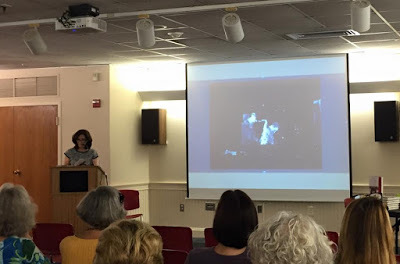
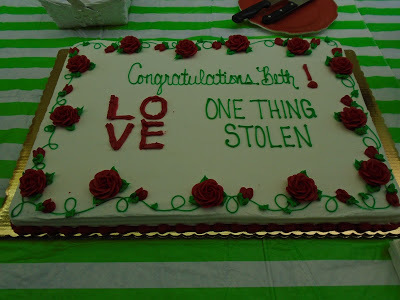
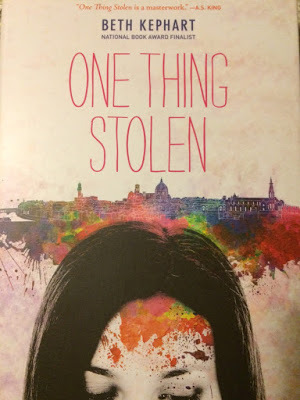 Some things aren't surprising when I am hosted by the Radnor Memorial Library. How gracious Pamela Sedor forever is. How delicious (and pretty) is that cake. How kind my friends, husband, and father are. I hope my gratitude is felt and known. I am fully aware of how precious time is, and what it means when time is set aside to support another's floating dreams.
Some things aren't surprising when I am hosted by the Radnor Memorial Library. How gracious Pamela Sedor forever is. How delicious (and pretty) is that cake. How kind my friends, husband, and father are. I hope my gratitude is felt and known. I am fully aware of how precious time is, and what it means when time is set aside to support another's floating dreams.But last night, after photographs and stories of this regional home were shared, after I read from One Thing Stolen, after I shared the opening pages of This Is the Story of You (and gave a copy to Lucky Number 9)—after all that, when I was signing books, I turned over a copy of One Thing Stolen and saw a new cover staring out at me. The formerly black title had turned red (and glossy). There were A.S. King words over my name. The back cover was different, too.
What had happened here?
A little detective work with Annie and Pam as the night wound down, and I learned this: One Thing Stolen has gone into a second printing and Chronicle Books has taken the time to dress the book up newly—new color, Amy's words. It's like those wondrous moments when I come in from a very long day and discover folded laundry on the kitchen table, the work of a secret elf. This thing had been done, quietly done, and there was my gratitude again.
So many, many thanks to Pam and Annie of Radnor, to my friends who came, to the ladies of the Wayne Art Center (oh we, the Hidden Gems), to Kelly, Cyndi, Marie, Tom, Hilary, Bill, another Bill, and Dad, and to Temple University Press, which gave me Love: A Philadelphia Affair and Chronicle Books, which gave me a second printing of One Thing Stolen as well as the gorgeous cover and packaging (and Taylor, thank you for caring so much, you read it again and then again with dedication; you kept asking; you kept pressing; I am grateful; we've made it all right at last) of This Is the Story of You.




Published on October 21, 2015 03:01
October 20, 2015
The Soul of an Octopus/Sy Montgomery: reflections
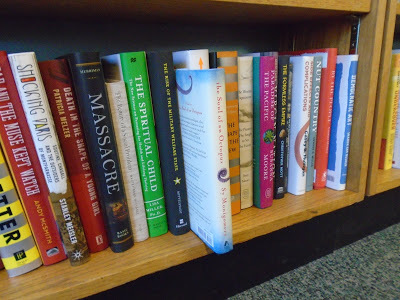 Last week I went in and out of three city bookstores. I might as well have traveled the world.
Last week I went in and out of three city bookstores. I might as well have traveled the world.In the glorious indie Penn Book Center, on the campus of the University of Pennsylvania, Ashley and I talked about who was reading what and why (a favorite conversation) and (in the midst of it all) I asked for a copy of Sy Montgomery's National Book Award nominated The Soul of an Octopus. Sy and I met when I reviewed her glorious book about swimming with the pink dolphins years ago. I've read all of books (for adults) since (Sy is an award-winning natural-world storyteller for children, too). And once, it seems ages ago, Sy and her friend and my husband and I sat in a restaurant just off Pine Street in Philly talking about the worlds we love.
The Soul of an Octopus is Sy's best book yet—and that is saying something. It's Sy as Sy—the intrepid explorer with the gonzo heart in the petite and capable body. It's Sy spending Wonderful Wednesdays with her friends at the New England Aquarium as they get to know—and be known by—a succession of form-shifting, camouflage-bedazzling, big-one-minute-squeezing-through-a-two-inch-crevasse-the-next octopuses. Sy falls in love with the first octopus touch. She begins to live on octopus time. She scubas into seas to see the wild octopus up close. And then she returns to the barrels and tanks and public displays to watch Octavia and Kali and Karma conveyor-belt food up their suction cups toward their mouths, beat with three hearts, unlock puzzles, and demonstrate intelligence, compassion, and personality akin to any human being.
But let's also pause right there, with human beings. Because, while Sy has always taken the time to introduce us to the other explorers and animal-kingdom lovers that she encounters in her wild adventures, we have never met characters quite like these—young people, older people, expert people, diving people, people with diagnoses, people with broken hearts, appreciating people. Sy's communities of octopus lovers are immaculately drawn. So much so that kindness (about which I was just recently musing, here) is as integral to this story as Sy's desire to understand octopus consciousness. Indeed, I would say the two are inextricable.
We can't help but love (even more) the wise and personality-prone octopus as we read (and finish) this book. We also can't help but love Sy.
I leave you with an early passage:
Perhaps, as we stroked her in the water, we entered into Athena's experience of time—liquid, slippery, and ancient, flowing at a different pace than any clock. I could stay here forever, filling my senses with Athena's strangeness and beauty, talking with my new friends.Congratulations, Sy.




Published on October 20, 2015 05:06
October 19, 2015
Philadelphia on the rise
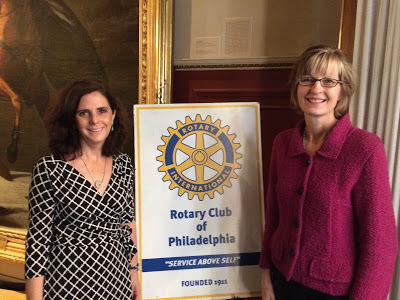
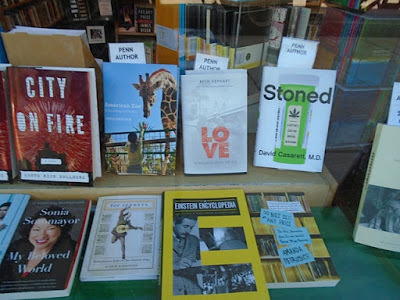



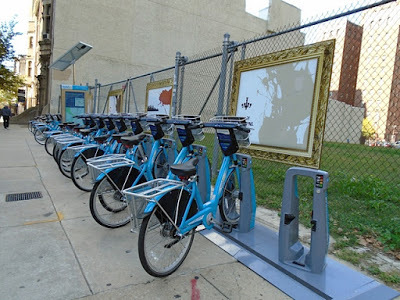 Last Thursday I hopped a train and did that thing I do—walked my city. The sun was bright. The air was crisp. And the city was (as it has been) on the rise. A few snapshots from the expedition, including some of the time I spent at the Union League, with the generous Rotarians.
Last Thursday I hopped a train and did that thing I do—walked my city. The sun was bright. The air was crisp. And the city was (as it has been) on the rise. A few snapshots from the expedition, including some of the time I spent at the Union League, with the generous Rotarians.



Published on October 19, 2015 07:16



